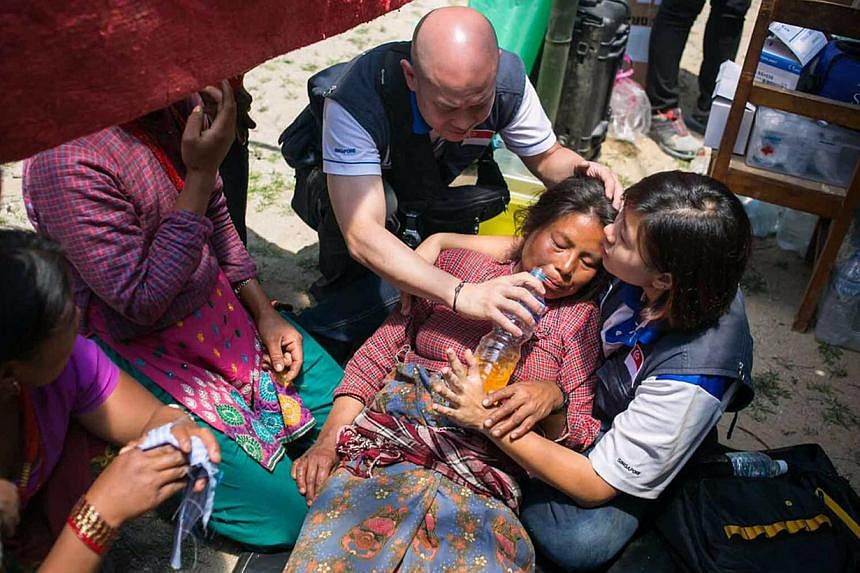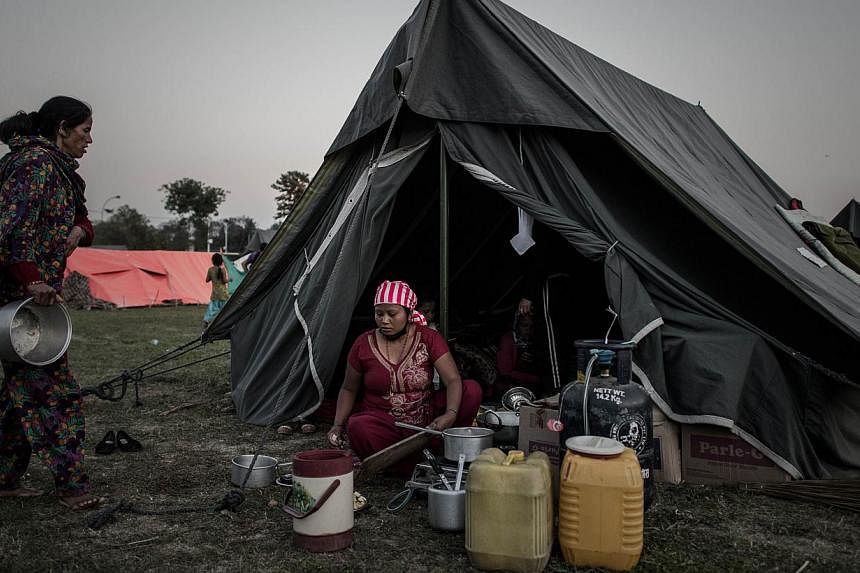On April 28, three days after Nepal was rocked by a 7.8-magnitude earthquake, Nepalese restaurateur Niranjan Kumar Shrestha, 45, lost his voice in Singapore.
This was after fielding about 1,000 phone calls from customers eager to donate relief supplies to his stricken countrymen. Since then, regulars at his nine-year-old eatery in Lorong 4 Toa Payoh have been inundating it with such gifts as flashlights, beverage packs and baby food.
On Wednesday, the married father of four, who is a Singapore permanent resident, was still receiving relief supplies, including 200 raincoats, 100 sleeping bags and a big box of medicine. He says: "Singaporeans have been so patient and kind, and these donations will be very valuable to the Nepalese, especially since the heavy monsoon rains are near."
But while most Singapore donors have been spot-on in realising exactly what the Nepalese need now, many other well-meaning donors elsewhere have been inadvertently jamming the country's narrow delivery and distribution channels with less-thought-through gifts.
As Nepalese Finance Minister Ram Sharan Mahat told the Associated Press wire agency last Friday: "We have received things like (tinned) tuna fish and mayonnaise. What good are these things for us? We need grains, salt and sugar."
Nepal is landlocked, so seafood hardly features in the Nepalese diet of mainly rice and lentils.
Tarpaulins instead of tents
SINGAPORE Red Cross (SRC) secretary-general and chief executive Benjamin Jeyaraj William, 58, says most countries would find it hard to absorb the deluge of relief supplies after a disaster, but this challenge is exacerbated in Nepal as it has only one entry point for all aid from abroad - that is, Tribhuvan Airport in Kathmandu.
Worse, the tarmac there was damaged in the quake, so the authorities have banned big planes, or those with over 40 tonnes of cargo, from landing there.
Mr William was told by colleagues in Kathmandu that the airport's workers are now taking 24 hours to clear even accompanied luggage, instead of the usual hour, because the government does not want contraband coming in under a humanitarian banner.
He notes: "Once your goods or services land in Kathmandu, you must have the relevant paperwork or a partner on the ground who's able to clear and distribute the goods. Otherwise, at every point that you choke up the relief supply chain, you're actually adding to the disaster."
SRC - which like other Red Cross societies marks World Red Cross Day today - has no clearance problems, but it has had to turn down a donation of 200 five-litre packs of drinking water in favour of funnelling more medical supplies through.
Mr William stresses that, now, the best donations in kind are: water-purification tablets, tarpaulins for shelter - as opposed to tents, which can weigh up to 80kg - and dry foods with long expiry dates. "At the moment, up to 40 people are sheltering under one tarpaulin sheet," he says.
As for food, Nepal's honorary consul here, Mr M.M. Patel, 61, is working with the Rotary Club of District 3310 - which covers Singapore, Malaysia and Brunei - to negotiate the freighting of packets of ready-mixed rice and soya beans, which cost about 50 cents a packet and can be boiled up quickly as porridge.
Singaporeans have been just as generous with their money. As of Wednesday, SRC had received more than $2.7 million in cash donations. Mercy Relief Singapore has chalked up more than $750,000, with $30,000 given on the day of the earthquake alone.
Meanwhile, on Tuesday, the Asian Development Bank (ADB) pledged US$200 million (S$265 million) to the cause, matching the Nepal government's outlay for reconstruction of US$200 million.
Aid agencies and Nepalese experts The Straits Times spoke to said Singaporeans keen to help restore Nepal to a stable footing should either continue to give money via accredited aid agencies they trust, or help rebuild homes, schools, medical centres, roads, bridges and railways there.
Circus comes to town
MERCY Relief chairman Michael Tay, 39, who is also group managing director of specialist watch retailer The Hour Glass, says that, with all the international do-gooders and the media descending on Nepal at the moment, "it's like the circus has come to town - all of a sudden, Nepal has worldwide attention".
"In a month, the relief phase will be over, all the international non-governmental organisations will go, and the Nepalese will be left scratching their heads, saying: 'What just happened?' "
So, he says, Nepal's government was "absolutely right" last week when it began welcoming only aid agencies, such as Mercy Relief, that are committed to staying on for at least three months beyond the relief phase, to kick-start the rebuilding of Nepal. After the Boxing Day 2004 tsunami, Mercy Relief continued to help rebuild Aceh until 2008; it is still helping the Philippines in the wake of Super Typhoon Haiyan in 2013.
Singapore-based Nepalese anti-earthquake engineer Mohan Sharma, 59, says making any country quake-resistant is "not that difficult"; the key is to "find ways to connect all walls of a building together so they move in unison when a quake shakes them". Dr Sharma - an alumnus of Stanford University who is director of modelling at catastrophe-management company Asia Risk Centre here - says most Nepalese houses are made from a combination of wooden beams and pillars with brick, stone or mud walls.
One way to strengthen such houses is to lash the wooden parts more tightly to the walls, with chicken wire mesh or the cane found easily in Nepal's forests. Concrete houses are a pipe dream for now, says Dr Sharma, as there are no town or village roads on which to transport steel bars.
In rebuilding, he notes, Nepal faces four big challenges:
- First, it needs a lot of money to strengthen, let alone rebuild, structures, in a country whose per capita income is US$700. The average Nepalese breadwinner has sunk life savings into buying the family home. The quake would be "a dead end" if it destroyed the home, as the family could not save as much to start over again.
- Second, most able-bodied Nepalese are working abroad, with about 300,000 in Malaysia alone. This leaves only the elderly and the very young in villages to clear the rubble left by the quake, before rebuilding can begin.
- Third, even if labourers are available, they need to be taught a lot of hard-to-grasp new skills fast.
- Fourth, the Himalayan mountain range is the world's youngest, so it is still geologically unstable. On Tuesday alone, it experienced five aftershocks.
Some able-bodied Nepalese are returning home in the wake of the quake. However, as Singapore-based Nepalese economist Pradumna Rana notes, they cannot stay for long. He says Nepal government data shows that at least 29 per cent of the country's gross domestic product (GDP) of about US$20 billion is from money they send home - his own study last year for ADB found that the official figure was an underestimate, having left out informal remittances such as money sent through friends or moneylenders. He put the actual figure at closer to 40 per cent of GDP.
Dr Rana, 68, who was at ADB for 27 years, highlights the need to monitor how reconstruction and rehabilitation funds are used, given Nepal's fragmented government and "poor track record" for governance and accountability. This means having people spot-check how many houses and schools are built and how fast progress is made, says Dr Rana, now an associate professor at the S. Rajaratnam School of International Studies, a local think-tank.
There is also a need for cash-for-works programmes as a stopgap reviver, to give people jobs and get the economy going again. For example, Nepal still has many artisans with the skills to re-create the country's 14 or so world heritage sites, 12 of which were destroyed in the quake.
Beyond all that, Dr Rana says, Nepal should seriously pursue a development strategy in which it uses its landlocked position to become a nerve centre for its neighbours.
This, he says, will pull in much-needed foreign investors and factories. He notes: "Nepal should become a Laos, which links Thailand with Cambodia and Vietnam, or a Mongolia, which links China with Russia."


